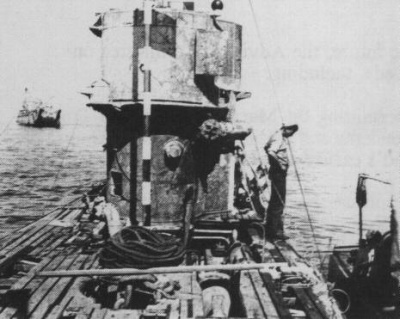
U-1105, nicknamed The Black Panther for its sonar-evading rubber coating, was sunk by the Navy in the Potomac River at Piney Point in 1949. The wreck, popular with advanced divers, is to be designated part of a protected marine area. Photo from the St. Mary's County Parks and Recreation Web site.
WASHINGTON (April 3, 2009) - The carcass of a World War II-era German submarine has rested for 60 years on the bottom of the Potomac River in Southern Maryland, visited only by sport divers and marine archeologists.
But now Maryland officials charged with protecting the U.S. Navy-owned U-boat are moving to add it to a new federal system of protected marine areas being created by the National Oceanic and Atmospheric Administration.
"It's nice to be part of a larger scientific system," said Susan Langley, underwater archeologist for the Maryland Department of Planning. "It's sort of bragging rights for Maryland."
The submarine's location, designated as the Black Panther Shipwreck Preserve, is one mile west of Piney Point Lighthouse in St. Mary's County.
Its route to Maryland began shortly after it was launched into service in June 1944 as part of the feared German U-boat fleet. The submarines patrolled the Atlantic Ocean in search of Allied supply convoys.
"At the beginning of the war, there was a very heavy toll on shipping," said Robert Neyland, head of underwater archeology for the Naval History and Heritage Command in the District.
Allied forces eventually reversed that early success. Better naval tactics, the cracking of Germany's "Enigma" code and the use of radar and sonar combined to sink more than 750 U-boats.
The Maryland sub is one of an estimated 10 coated with an experimental rubber skin designed to elude Allied sonar; it earned the nickname "Black Panther."
"It was an early attempt at stealth technology," Langley said. "It does seem to be the precursor to the rubber coating that the Russian and American subs began using later."
The ship completed just one mission, disabling a British destroyer off the coast of Ireland. Seven days later it received notice that the war was over and surrendered to Allied forces in Scotland.
The U.S. Navy brought the sub to New Hampshire, where researchers studied the rubber coating. The Navy then used the sub to test mines and depth charges before sinking it in 90 feet of water in 1949.
Recreational divers led by Uwe Lovas discovered the sub in 1985. Lovas, who lives in Alexandria, Va., saw an entry for the Black Panther while poring over Navy records of seized U-boats at the Washington Navy Yard.
The listed coordinates for the wreck placed it in the Atlantic Ocean, Lovas said. But he realized the numbers were transposed and that it was lying in the Potomac.
The Black Panther was largely intact when he found it, said Lovas, who also discovered the U-701, which sank off the North Carolina coast in 1942.
"The conning tower and all the features were very close to how it was when it was sunk," he said of the Black Panther.
An archeological survey conducted on the Black Panther eight years after Lovas' discovery led to the wreck's designation in 1994 as Maryland's first shipwreck preserve.
The state was then able to develop a management plan and clean up the site with the help of a $50,000 grant from the Department of Defense.
John Kiser, the owner of Sea Colony Aqua Sports in Severna Park, guided the survey and has visited the site 60 times by his estimate.
The fresh water of the Potomac has kept the Black Panther in "very good" shape, Kiser said, although it is mostly submerged in mud and slightly bowed from a depth charge explosion.
It was Sea Colony that removed the periscope, hatches and running lights that are among the artifacts now exhibited at the Piney Point Museum, Kiser said.
The sub's innovations go beyond the rubber coating, he said. The Black Panther possessed a "snorkel" that could be raised to expel exhaust. The pipe allowed the sub to use its more-powerful diesel engines underwater, instead of electric ones.
It was also outfitted with a device that when raised could detect radar scanning by Allied ships, Kiser said.
"In that time, it was very incredible," Kiser said. "They had submarine technology that we hadn't even started to think of."
The preserve designation creates a buffer zone around the site, which is marked with a buoy. Dredging nearby is prohibited, and boats are not allowed to anchor within 600 feet, said Catherine McCall of the Maryland Department of Natural Resources.
"It really is a unique submerged cultural resource," said McCall, a planner with DNR's Chesapeake and Coastal Program.
Neyland helped develop the preserve when he began working in 1994 at the Naval History and Heritage Command, which manages shipwreck sites around the world.
"That was right about the time when people were starting to turn shipwrecks into preserves," Neyland said.
The Navy is "quite pleased" with the Black Panther preserve, he said, adding that "it's probably one of the better-preserved U-boats around."
During summer months, about 20 to 30 divers brave the Potomac's dark waters to see the submarine, Langley said. Law enforcement agencies and the military also use it for training.
"It's considered a very advanced dive," she said. "I don't recommend it very lightly."
There are alternatives, however. The waters off the coast of Ocean City are littered with wrecks, Kiser said.
"People don't realize what the Germans accomplished off our shores," he said. "There's literally hundreds of wrecks."
Capital News Service contributed to this report.


